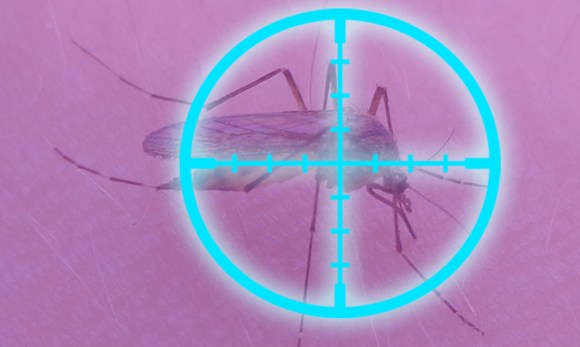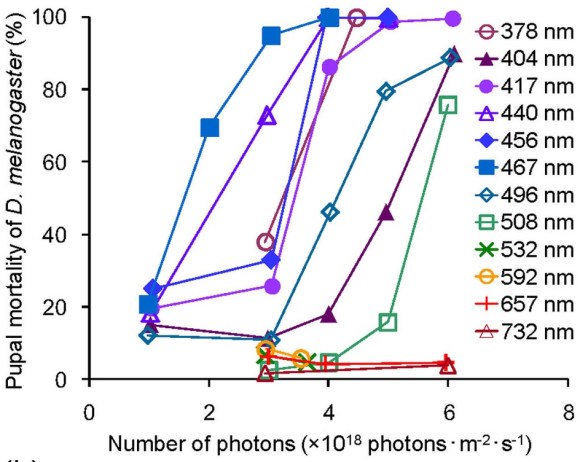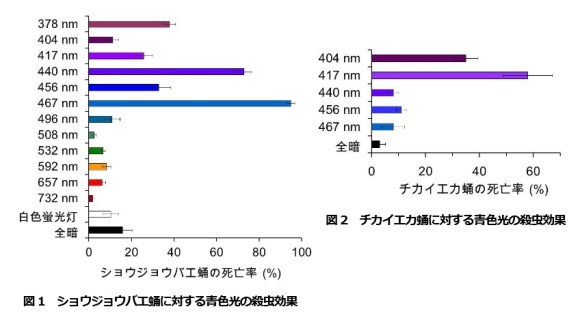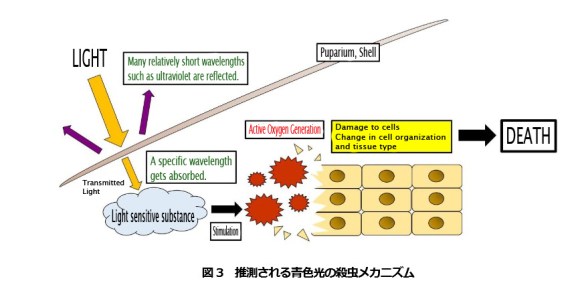
Earlier this year Isamu Akasaki, Hiroshi Amano, and Shuji Nakamura won the Nobel Prize in Physics for their development of an efficient blue light-emitting diode (blue LED).
It was a well-deserved victory for the Japanese scientists whose invention continues to impact our lives in ways we often don’t even notice. It could be in the display you’re looking at right now or it could be helping some of the millions of people in parts of the world without electrical infrastructure get affordable lights for their homes.
And now in a report published in Scientific Reports, a team of researchers from Tohoku University have found a new use for blue LED. When used in the right frequency it can be an effective, safe, clean, and cheap way to kill insects. For the first time, they showed that visible light around the blue part of the spectrum is lethal to insects such as mosquitoes and fruit flies.
■ Red light at night, insects’ delight
In the experiment, the team of Masatoshi Hori, Kazuki Shibuya, Mitsunari Sato, and Yoshino Sato gathered samples of three species of insects; fruit flies (Drosophila melanogaster), London Underground mosquito (Culex pipiens f. molestus), and confused flour beetles (Tribolium confusum). The names of these bugs are probably worthy of their own article, but we can’t get sidetracked now.
The team then hit these insects with different intensities of colored lights at different stages of their development from egg to adult. Interestingly, they found that wavelengths of light from ultraviolet (378 nanometers) to visible blue-green (508nm) killed off the bugs, whereas wavelengths of light in red and yellow had essentially no effect.
■ Different lights for different bugs
Even more interestingly, the wavelength of light did not directly correspond to its lethalness. For example, fruit flies dropped dead with under a 467nm far more efficiently than with any other longer or shorter wavelengths. Mosquitoes on the other hand were weaker to a more lavender 417nm wavelength light. When swapped, only a few fruit flies went down under 417nm, whereas mosquitoes barely flinched at the 467nm light.
▼ Graphs showing the percentage of fruit flies (figure1) and mosquitoes (figure2) killed by different wavelengths of light. Notice that simple blue light was far more effective than UV light against fruit flies.
It’s as if every species of insect had their own unique “key” wavelength that unlocked their demise. In addition each insect’s weakness to visible light seemed to correspond to their own lifestyles. Mosquitos tend to fly freely in the sunlight, and as such they are also resilient against most wavelengths except for a relatively high dose of purple light.
Confused flour beetles however, tend to live in dark environments and also happen to be weak against a wider range of wavelengths (404nm to 467nm). It appears that the behavior of these creatures is not to avoid light altogether, but rather to avoid certain concentrations of certain wavelengths of light contained in sunlight.
■ How does it work?
This all leaves us with the question of why this works. That’s a little outside of the scope of this experiment, but the Tohoku U team presumes it’s similar to the damaging effects UV light can have on cells.
In the case of blue/violet lights on insects, certain wavelengths appear to stimulate the production of a type of molecule called reactive oxygen species (ROS). These molecules begin to wreak havoc on a cellular level leading up to significant tissue damage in the insect and ultimately death.
While the exact mechanics aren’t completely known, it has been determined that regular light in just the right measures and doses can be an incredibly effective insecticide. This means we may some day be able to control crop destroying and disease carrying pests cheaply, easily, and without the use of dangerous poisons.
This also shows us that even simple things like blue lights have powers we may not fully comprehend yet. Now if you’ll excuse me, I have to dig those old PC glasses out of the closet.
Source: Scientific Reports (English), Tohoku University 1, 2 (Japanese)
Top Image: Wikipedia – AfroBrazillian (modified by RocketNews24)




 Anti-insect laser gun turrets designed by Osaka University, expected to work on roaches too
Anti-insect laser gun turrets designed by Osaka University, expected to work on roaches too As summer comes to an end, it’s time to get ready for a plague of mosquitoes in Japan
As summer comes to an end, it’s time to get ready for a plague of mosquitoes in Japan What colors of clothing will keep you cooler in summer? Japanese researchers experiment
What colors of clothing will keep you cooler in summer? Japanese researchers experiment What do Kamen Rider and Darth Vader have in common? They’re both in this (insane) video!
What do Kamen Rider and Darth Vader have in common? They’re both in this (insane) video! Think mosquitoes suck? Japan’s Shock Extermination Stick lets you suck some mosquitoes instead
Think mosquitoes suck? Japan’s Shock Extermination Stick lets you suck some mosquitoes instead Foreigner’s request for help in Tokyo makes us sad for the state of society
Foreigner’s request for help in Tokyo makes us sad for the state of society Red light district sushi restaurant in Tokyo shows us just how wrong we were about it
Red light district sushi restaurant in Tokyo shows us just how wrong we were about it Pokémon Sleep camping suite and guestrooms coming to Tokyo Hyatt along with giant Snorlax burgers
Pokémon Sleep camping suite and guestrooms coming to Tokyo Hyatt along with giant Snorlax burgers Ghibli Park now selling “Grilled Frogs” from food cart in Valley of Witches
Ghibli Park now selling “Grilled Frogs” from food cart in Valley of Witches Japanese city loses residents’ personal data, which was on paper being transported on a windy day
Japanese city loses residents’ personal data, which was on paper being transported on a windy day Historical figures get manga makeovers from artists of Spy x Family, My Hero Academia and more
Historical figures get manga makeovers from artists of Spy x Family, My Hero Academia and more Anime girl English teacher Ellen-sensei becomes VTuber/VVTUber and NFT
Anime girl English teacher Ellen-sensei becomes VTuber/VVTUber and NFT Japanese ramen restaurants under pressure from new yen banknotes
Japanese ramen restaurants under pressure from new yen banknotes French Fries Bread in Tokyo’s Shibuya becomes a hit on social media
French Fries Bread in Tokyo’s Shibuya becomes a hit on social media Is Japan’s massive Shizuoka steak sandwich really as delicious as it looks in promo photos?
Is Japan’s massive Shizuoka steak sandwich really as delicious as it looks in promo photos? McDonald’s new Happy Meals offer up cute and practical Sanrio lifestyle goods
McDonald’s new Happy Meals offer up cute and practical Sanrio lifestyle goods All-you-can-drink Starbucks and amazing views part of Tokyo’s new 170 meter-high sky lounge
All-you-can-drink Starbucks and amazing views part of Tokyo’s new 170 meter-high sky lounge Studio Ghibli releases new action figures featuring Nausicaä of the Valley of the Wind characters
Studio Ghibli releases new action figures featuring Nausicaä of the Valley of the Wind characters New private rooms on Tokaido Shinkansen change the way we travel from Tokyo to Kyoto
New private rooms on Tokaido Shinkansen change the way we travel from Tokyo to Kyoto Studio Ghibli glasses cases let anime characters keep an eye on your spectacles
Studio Ghibli glasses cases let anime characters keep an eye on your spectacles Tokyo Tsukiji fish market site to be redeveloped with 50,000-seat stadium, hotel, shopping center
Tokyo Tsukiji fish market site to be redeveloped with 50,000-seat stadium, hotel, shopping center Beautiful Ghibli sealing wax kits let you create accessories and elegant letter decorations【Pics】
Beautiful Ghibli sealing wax kits let you create accessories and elegant letter decorations【Pics】 Studio Ghibli releases Kiki’s Delivery Service chocolate cake pouches in Japan
Studio Ghibli releases Kiki’s Delivery Service chocolate cake pouches in Japan New definition of “Japanese whiskey” goes into effect to prevent fakes from fooling overseas buyers
New definition of “Japanese whiskey” goes into effect to prevent fakes from fooling overseas buyers Our Japanese reporter visits Costco in the U.S., finds super American and very Japanese things
Our Japanese reporter visits Costco in the U.S., finds super American and very Japanese things Studio Ghibli unveils Mother’s Day gift set that captures the love in My Neighbour Totoro
Studio Ghibli unveils Mother’s Day gift set that captures the love in My Neighbour Totoro New Japanese KitKat flavour stars Sanrio characters, including Hello Kitty
New Japanese KitKat flavour stars Sanrio characters, including Hello Kitty More foreign tourists than ever before in history visited Japan last month
More foreign tourists than ever before in history visited Japan last month New Pokémon cakes let you eat your way through Pikachu and all the Eevee evolutions
New Pokémon cakes let you eat your way through Pikachu and all the Eevee evolutions Sales of Japan’s most convenient train ticket/shopping payment cards suspended indefinitely
Sales of Japan’s most convenient train ticket/shopping payment cards suspended indefinitely Sold-out Studio Ghibli desktop humidifiers are back so Totoro can help you through the dry season
Sold-out Studio Ghibli desktop humidifiers are back so Totoro can help you through the dry season Japanese government to make first change to romanization spelling rules since the 1950s
Japanese government to make first change to romanization spelling rules since the 1950s Ghibli founders Toshio Suzuki and Hayao Miyazaki contribute to Japanese whisky Totoro label design
Ghibli founders Toshio Suzuki and Hayao Miyazaki contribute to Japanese whisky Totoro label design Doraemon found buried at sea as scene from 1993 anime becomes real life【Photos】
Doraemon found buried at sea as scene from 1993 anime becomes real life【Photos】 Tokyo’s most famous Starbucks is closed
Tokyo’s most famous Starbucks is closed One Piece characters’ nationalities revealed, but fans have mixed opinions
One Piece characters’ nationalities revealed, but fans have mixed opinions We asked a Uniqlo employee what four things we should buy and their suggestions didn’t disappoint
We asked a Uniqlo employee what four things we should buy and their suggestions didn’t disappoint Princesses, fruits, and blacksmiths: Study reveals the 30 most unusual family names in Japan
Princesses, fruits, and blacksmiths: Study reveals the 30 most unusual family names in Japan LED plant factories offer efficient 3D alternative to traditional gardening
LED plant factories offer efficient 3D alternative to traditional gardening Super bug — Japanese entomologist encounters a real-life titan, but of the insect variety
Super bug — Japanese entomologist encounters a real-life titan, but of the insect variety Japanese Twitter artist’s cute anime girl rendition of a mosquito is so accurate it hurts
Japanese Twitter artist’s cute anime girl rendition of a mosquito is so accurate it hurts Earth Chemical to change name of insecticide products to “insect care products”
Earth Chemical to change name of insecticide products to “insect care products” Japan’s better farming through precision drone strikes
Japan’s better farming through precision drone strikes Why isn’t there more deer poo in Nara Park? This very strange museum has the answer【Photos】
Why isn’t there more deer poo in Nara Park? This very strange museum has the answer【Photos】 How to stop the itching from a mosquito bite in minutes using a towel and a microwave
How to stop the itching from a mosquito bite in minutes using a towel and a microwave Roses and cherry blossoms help to repel wasp attacks, according to Kochi University study
Roses and cherry blossoms help to repel wasp attacks, according to Kochi University study Cosplay mosquito repellent? Japan’s new magical-armor-style accessory protects you from bugs
Cosplay mosquito repellent? Japan’s new magical-armor-style accessory protects you from bugs Spoons and bowls that use electricity to make food taste saltier to go on sale in 2023
Spoons and bowls that use electricity to make food taste saltier to go on sale in 2023 Babies understand that people with supernatural powers are better, according to Japanese study
Babies understand that people with supernatural powers are better, according to Japanese study Better than mosquito repellent – The most eco-friendly (and spiritual) way to repel pests in Japan
Better than mosquito repellent – The most eco-friendly (and spiritual) way to repel pests in Japan First new Japanese cockroach species in 35 years discovered by scientists【Photos】
First new Japanese cockroach species in 35 years discovered by scientists【Photos】 New species of mayfly discovered in Fukushima that can never get their prescription glasses
New species of mayfly discovered in Fukushima that can never get their prescription glasses Class up your backyard with your very own Nazca hummingbird that smells so good!
Class up your backyard with your very own Nazca hummingbird that smells so good! Three centipede and cockroach species are newly named and placed under protection in Okinawa
Three centipede and cockroach species are newly named and placed under protection in Okinawa Bug hunt! Some areas offering rewards for alien beetles threatening Japan’s cherry blossoms
Bug hunt! Some areas offering rewards for alien beetles threatening Japan’s cherry blossoms
Leave a Reply